Презентация political world map


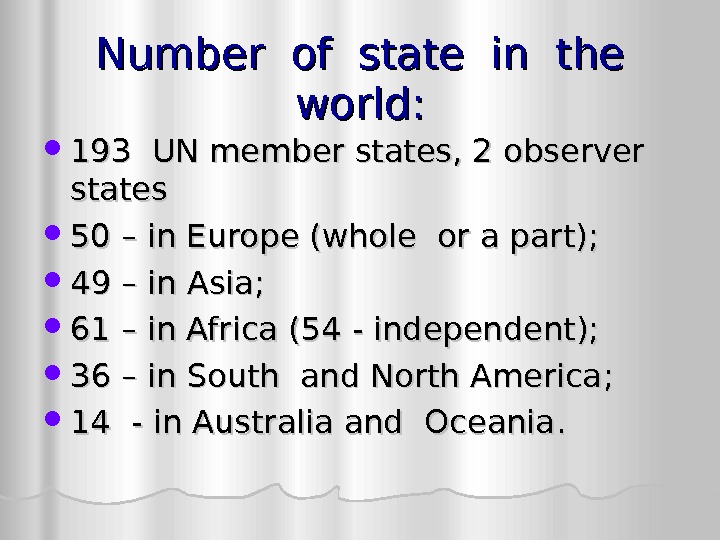
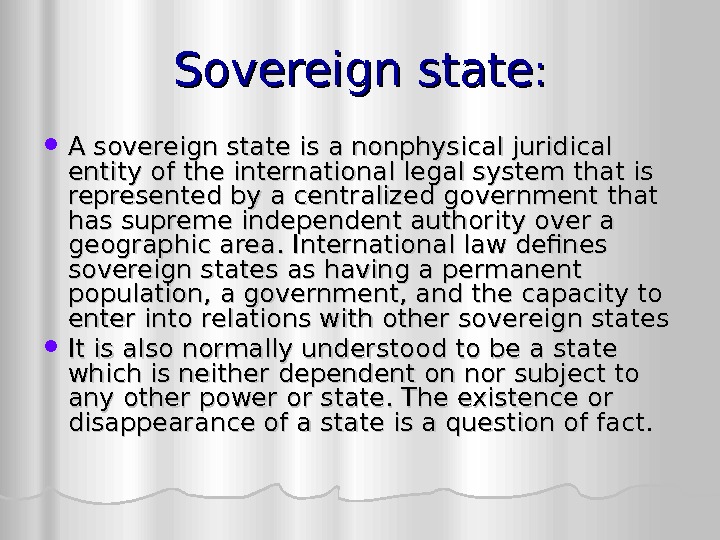
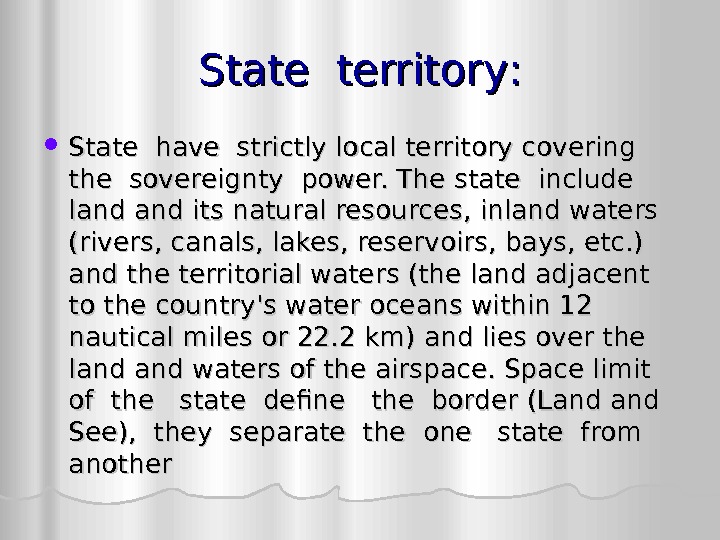
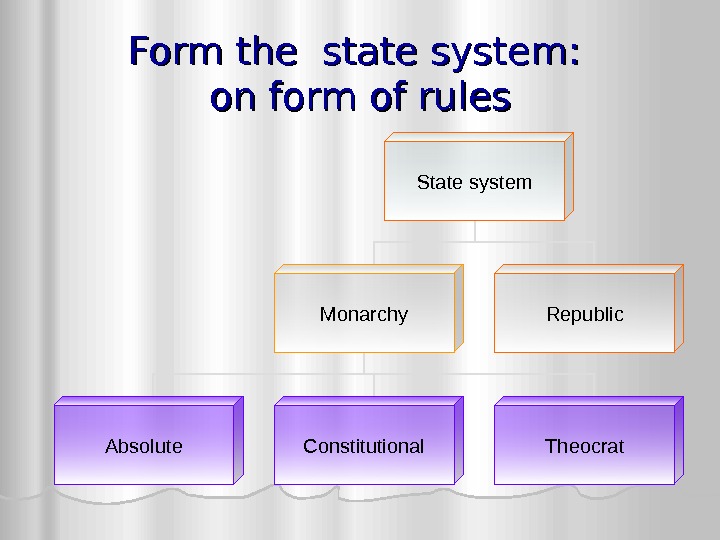

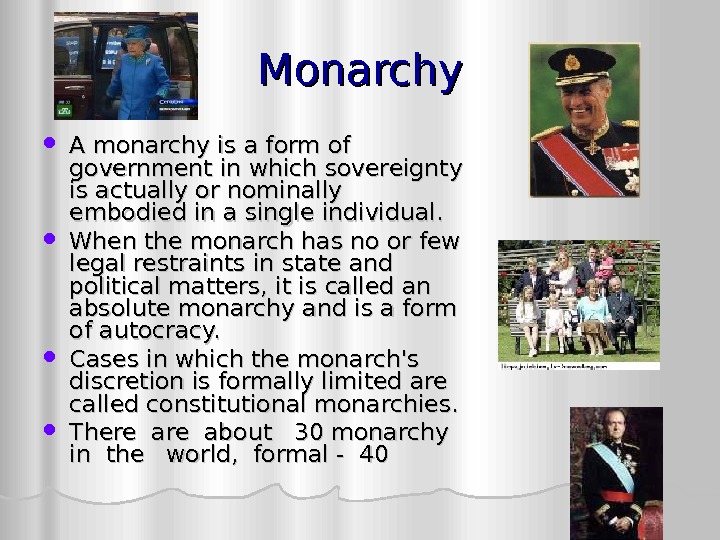

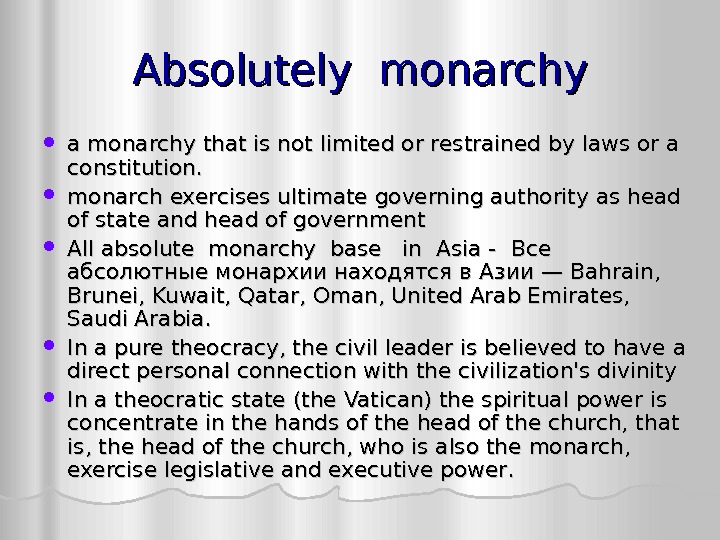


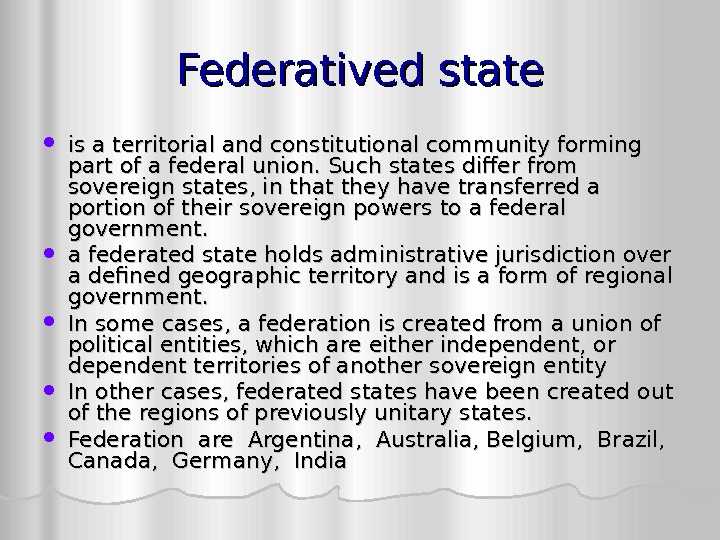

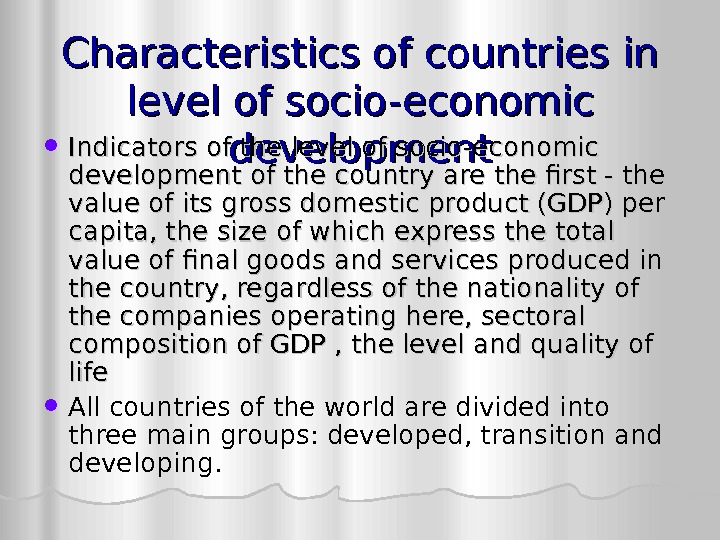






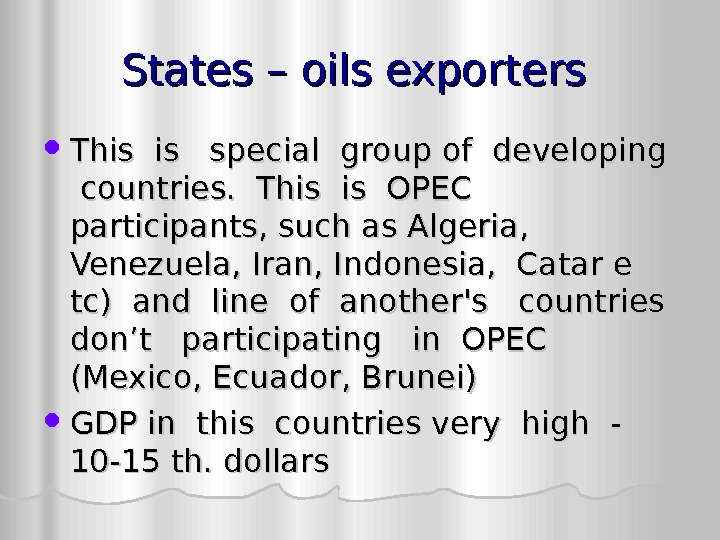

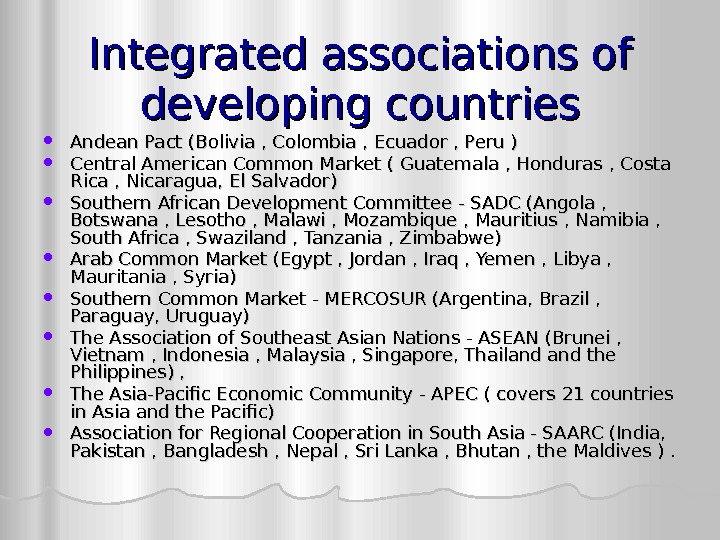
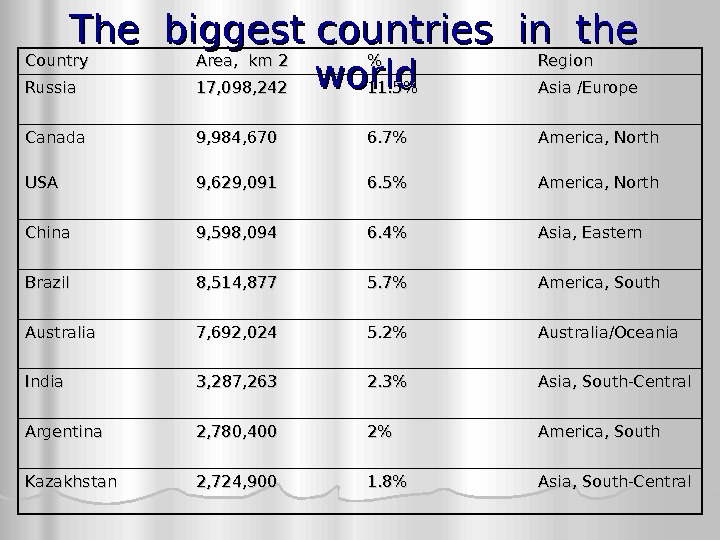



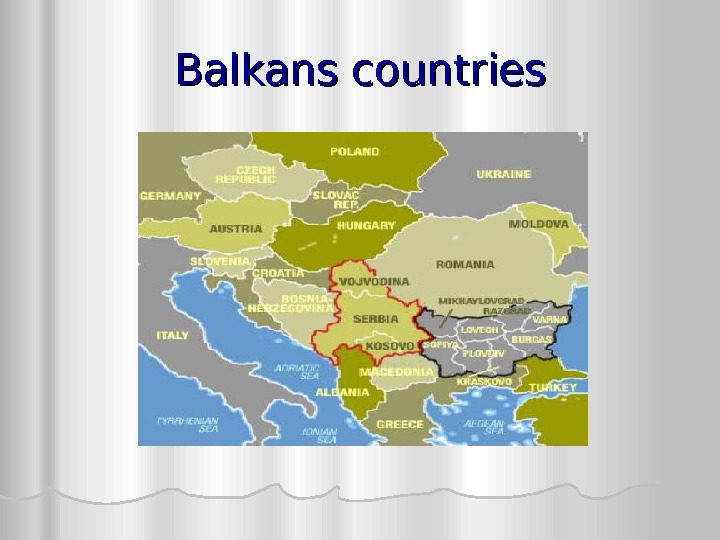
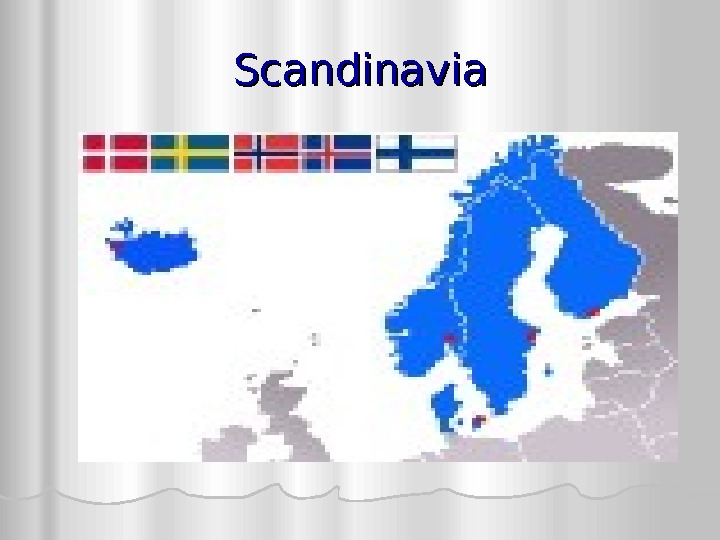
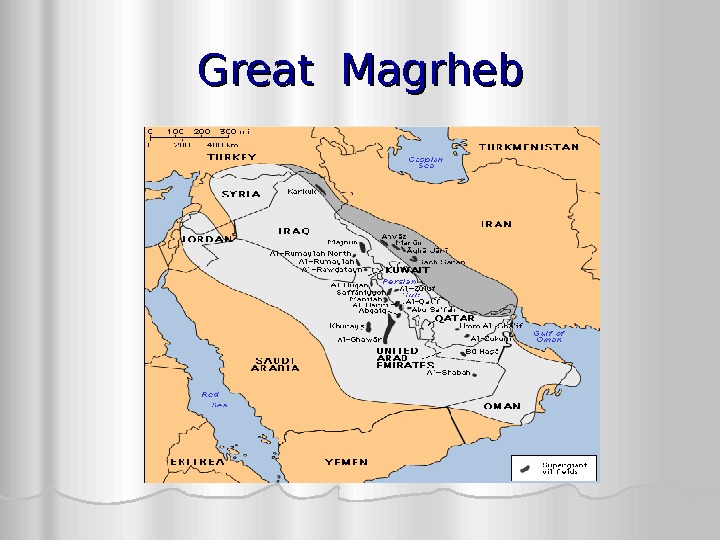
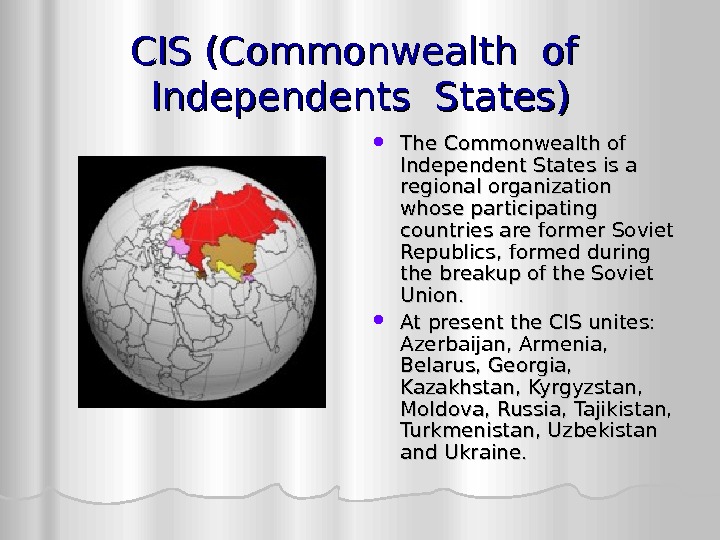
- Размер: 6.7 Mегабайта
- Количество слайдов: 32
Описание презентации Презентация political world map по слайдам
 Introduction to Regional studies Topic : « Political world map » »
Introduction to Regional studies Topic : « Political world map » »

 Number of state in the world : : 193 UN member states, 2 observer states 50 – in Europe (whole or a part) ; ; 44 99 – – in Asia ; ; 6161 – – in Africa ( ( 54 — independent ); ); 33 66 – – in South and North America ; ; 14 14 — in Australia and Oceania. .
Number of state in the world : : 193 UN member states, 2 observer states 50 – in Europe (whole or a part) ; ; 44 99 – – in Asia ; ; 6161 – – in Africa ( ( 54 — independent ); ); 33 66 – – in South and North America ; ; 14 14 — in Australia and Oceania. .
 Sovereign state : : A sovereign state is a nonphysical juridical entity of the international legal system that is represented by a centralized government that has supreme independent authority over a geographic area. International law defines sovereign states as having a permanent population, a government, and the capacity to enter into relations with other sovereign states It is also normally understood to be a state which is neither dependent on nor subject to any other power or state. The existence or disappearance of a state is a question of fact.
Sovereign state : : A sovereign state is a nonphysical juridical entity of the international legal system that is represented by a centralized government that has supreme independent authority over a geographic area. International law defines sovereign states as having a permanent population, a government, and the capacity to enter into relations with other sovereign states It is also normally understood to be a state which is neither dependent on nor subject to any other power or state. The existence or disappearance of a state is a question of fact.
 State territory : : State have strictly local territory covering the sovereignty power. The state include land and its natural resources, inland waters (rivers, canals, lakes, reservoirs, bays, etc. ) and the territorial waters (the land adjacent to the country’s water oceans within 12 nautical miles or 22. 2 km) and lies over the land and waters of the airspace. Space limit of the state define the border (( Land and See ), ), they separate the one state from another
State territory : : State have strictly local territory covering the sovereignty power. The state include land and its natural resources, inland waters (rivers, canals, lakes, reservoirs, bays, etc. ) and the territorial waters (the land adjacent to the country’s water oceans within 12 nautical miles or 22. 2 km) and lies over the land and waters of the airspace. Space limit of the state define the border (( Land and See ), ), they separate the one state from another
 Form the state system : : on form of rules State system Monarchy Republic Absolute Constitutional Theocrat
Form the state system : : on form of rules State system Monarchy Republic Absolute Constitutional Theocrat
 Republic republic a form of government in which affairs of state are a «public matter», not the private concern of the rulers, in which public offices are subsequently appointed or elected rather than privately accommodated Republic are 75 %% state in the world. Republic are USA, German, Italy, India, Turkey, China and many others
Republic republic a form of government in which affairs of state are a «public matter», not the private concern of the rulers, in which public offices are subsequently appointed or elected rather than privately accommodated Republic are 75 %% state in the world. Republic are USA, German, Italy, India, Turkey, China and many others
 Monarchy A monarchy is a form of government in which sovereignty is actually or nominally embodied in a single individual. When the monarch has no or few legal restraints in state and political matters, it is called an absolute monarchy and is a form of autocracy. Cases in which the monarch’s discretion is formally limited are called constitutional monarchies. There are about 30 monarchy in the world, formal —
Monarchy A monarchy is a form of government in which sovereignty is actually or nominally embodied in a single individual. When the monarch has no or few legal restraints in state and political matters, it is called an absolute monarchy and is a form of autocracy. Cases in which the monarch’s discretion is formally limited are called constitutional monarchies. There are about 30 monarchy in the world, formal —
 Constitutional monarchy A constitutional monarchy is a form of government in which a monarch acts as head of state within the parameters of a written (i. e. , codified), unwritten (i. e. , uncodified) or blended constitution. . Contemporary constitutional monarchies include The Bahamas, Barbados, Belgium, Belize, Bhutan, Cambodia, Canada, Denmark, Grenada, Jamaica, Japan, Jordan, Liechtenstein, Lesotho, Luxembourg, Malaysia, Monaco, Morocco, the Netherlands, Norway, Papua New Guinea, Saint Vincent and the Grenadines, Solomon Islands, Spain, Sweden, Thailand, Tuvalu, and the United Kingdom.
Constitutional monarchy A constitutional monarchy is a form of government in which a monarch acts as head of state within the parameters of a written (i. e. , codified), unwritten (i. e. , uncodified) or blended constitution. . Contemporary constitutional monarchies include The Bahamas, Barbados, Belgium, Belize, Bhutan, Cambodia, Canada, Denmark, Grenada, Jamaica, Japan, Jordan, Liechtenstein, Lesotho, Luxembourg, Malaysia, Monaco, Morocco, the Netherlands, Norway, Papua New Guinea, Saint Vincent and the Grenadines, Solomon Islands, Spain, Sweden, Thailand, Tuvalu, and the United Kingdom.
 Absolutely monarchy a monarchy that is not limited or restrained by laws or a constitution. monarch exercises ultimate governing authority as head of state and head of government All absolute monarchy base in Asia — Все абсолютные монархии находятся в Азии — Bahrain, Brunei, Kuwait, Qatar, Oman, United Arab Emirates, Saudi Arabia. In a pure theocracy, the civil leader is believed to have a direct personal connection with the civilization’s divinity In a theocratic state (the Vatican) the spiritual power is concentrate in the hands of the head of the church, that is, the head of the church, who is also the monarch, exercise legislative and executive power. .
Absolutely monarchy a monarchy that is not limited or restrained by laws or a constitution. monarch exercises ultimate governing authority as head of state and head of government All absolute monarchy base in Asia — Все абсолютные монархии находятся в Азии — Bahrain, Brunei, Kuwait, Qatar, Oman, United Arab Emirates, Saudi Arabia. In a pure theocracy, the civil leader is believed to have a direct personal connection with the civilization’s divinity In a theocratic state (the Vatican) the spiritual power is concentrate in the hands of the head of the church, that is, the head of the church, who is also the monarch, exercise legislative and executive power. .
 From the view of ATD has the following forms of government: State system Federatived Unitary Confederative
From the view of ATD has the following forms of government: State system Federatived Unitary Confederative
 Unitary state is a sovereign state governed as a single entity. The central government is supreme, and the administrative divisions exercise only powers that the central government has delegated to them. Subdivisional units are created and abolished, and their powers may be broadened and narrowed by the central government. More than 150 countries are unitary states, including France, China, and Japan.
Unitary state is a sovereign state governed as a single entity. The central government is supreme, and the administrative divisions exercise only powers that the central government has delegated to them. Subdivisional units are created and abolished, and their powers may be broadened and narrowed by the central government. More than 150 countries are unitary states, including France, China, and Japan.
 Federatived state is a territorial and constitutional community forming part of a federal union. Such states differ from sovereign states, in that they have transferred a portion of their sovereign powers to a federal government. a federated state holds administrative jurisdiction over a defined geographic territory and is a form of regional government. In some cases, a federation is created from a union of political entities, which are either independent, or dependent territories of another sovereign entity In other cases, federated states have been created out of the regions of previously unitary states. Federation are Argentina, Australia, Belgium, Brazil, Canada, Germany, India
Federatived state is a territorial and constitutional community forming part of a federal union. Such states differ from sovereign states, in that they have transferred a portion of their sovereign powers to a federal government. a federated state holds administrative jurisdiction over a defined geographic territory and is a form of regional government. In some cases, a federation is created from a union of political entities, which are either independent, or dependent territories of another sovereign entity In other cases, federated states have been created out of the regions of previously unitary states. Federation are Argentina, Australia, Belgium, Brazil, Canada, Germany, India
 Confederation a permanent union of political units for common action in relation to other units. Usually created by treaty but often later adopting a common constitution, confederations tend to be established for dealing with critical issues, with the central government being required to provide support for all members. Swiss is only one confederation in the world
Confederation a permanent union of political units for common action in relation to other units. Usually created by treaty but often later adopting a common constitution, confederations tend to be established for dealing with critical issues, with the central government being required to provide support for all members. Swiss is only one confederation in the world
 Characteristics of countries in level of socio-economic development Indicators of the level of socio-economic development of the country are the first — the value of its gross domestic product (GDP) per capita, the size of which express the total value of final goods and services produced in the country, regardless of the nationality of the companies operating here, sectoral composition of GDP , the level and quality of life All countries of the world are divided into three main groups: developed, transition and developing.
Characteristics of countries in level of socio-economic development Indicators of the level of socio-economic development of the country are the first — the value of its gross domestic product (GDP) per capita, the size of which express the total value of final goods and services produced in the country, regardless of the nationality of the companies operating here, sectoral composition of GDP , the level and quality of life All countries of the world are divided into three main groups: developed, transition and developing.
 Political maps of the West Europe
Political maps of the West Europe
 Developed countries A developed country or «more developed country» (MDC), is a sovereign state that has a highly developed economy and advanced technological infrastructure relative to other less developed nations. Developed countries have post-industrial economies, meaning the service sector provides more wealth than the industrial sector. According to the International Monetary Fund, advanced economies comprise 65. 8% of global nominal GDP and 52. 1% of global GDP (PPP) in 2010. In 2011, the nine largest advanced economies by either nominal GDP or GDP (PPP) are the United States, the United Kingdom, Germany, France, Japan, Italy, Canada, Spain and South Korea. GDP per capita by country (World Bank, 2011)
Developed countries A developed country or «more developed country» (MDC), is a sovereign state that has a highly developed economy and advanced technological infrastructure relative to other less developed nations. Developed countries have post-industrial economies, meaning the service sector provides more wealth than the industrial sector. According to the International Monetary Fund, advanced economies comprise 65. 8% of global nominal GDP and 52. 1% of global GDP (PPP) in 2010. In 2011, the nine largest advanced economies by either nominal GDP or GDP (PPP) are the United States, the United Kingdom, Germany, France, Japan, Italy, Canada, Spain and South Korea. GDP per capita by country (World Bank, 2011)
 Transition countries Although the term «transition economies» usually covers the countries of Central and Eastern Europe and the Former Soviet Union. There are countries outside of Europe, emerging from a socialist-type command economy towards a market-based economy (e. g. , China). Moreover, in a wider sense the definition of transition economy refers to all countries which attempt to change their basic constitutional elements towards market-style fundamentals. Their origin could be also in a post-colonial situation, in a heavily regulated Asian-style economy, in a Latin American post-dictatorship or even in a somehow economically underdeveloped country in Africa. The eight first-wave accession countries, which joined the European Union on 1 May 2004 (Czech Republic, Estonia, Hungary, Latvia, Lithuania, Poland, Slovakia, Slovenia) and the two second-wave accession countries that joined in 1 January 2007 (Romania and Bulgaria) have completed the transition process.
Transition countries Although the term «transition economies» usually covers the countries of Central and Eastern Europe and the Former Soviet Union. There are countries outside of Europe, emerging from a socialist-type command economy towards a market-based economy (e. g. , China). Moreover, in a wider sense the definition of transition economy refers to all countries which attempt to change their basic constitutional elements towards market-style fundamentals. Their origin could be also in a post-colonial situation, in a heavily regulated Asian-style economy, in a Latin American post-dictatorship or even in a somehow economically underdeveloped country in Africa. The eight first-wave accession countries, which joined the European Union on 1 May 2004 (Czech Republic, Estonia, Hungary, Latvia, Lithuania, Poland, Slovakia, Slovenia) and the two second-wave accession countries that joined in 1 January 2007 (Romania and Bulgaria) have completed the transition process.
 Developing countries A developing country, also called a less-developed country (LDC), is a nation with a low living standard, underdeveloped industrial base, and low Human Development Index (HDI) relative to other countries. There is no universal, agreed-upon criterion for what makes a country developing versus developed and which countries fit these two categories, although there are general reference points such as a nation’s GDP per capita compared to other nations. Countries with more advanced economies than other developing nations but that have not yet demonstrated signs of a developed country, are often categorized under the term newly industrialized countries.
Developing countries A developing country, also called a less-developed country (LDC), is a nation with a low living standard, underdeveloped industrial base, and low Human Development Index (HDI) relative to other countries. There is no universal, agreed-upon criterion for what makes a country developing versus developed and which countries fit these two categories, although there are general reference points such as a nation’s GDP per capita compared to other nations. Countries with more advanced economies than other developing nations but that have not yet demonstrated signs of a developed country, are often categorized under the term newly industrialized countries.
 New industrialized states The category of newly industrialized country (NIC) is a socioeconomic classification applied to several countries around the world by political scientists and economists. NICs are countries whose economies have not yet reached developed country status but have, in a macroeconomic sense, outpaced their developing counterparts. Another characterization of NICs is that of nations undergoing rapid economic growth (usually export-oriented). Incipient or ongoing industrialization is an important indicator of a NIC. In many NICs, social upheaval can occur as primarily rural, or agricultural, populations migrate to the cities, where the growth of manufacturing concerns and factories can draw many thousands of laborers. NICs usually share some other common features, including: Increased social freedoms and civil rights. [dubious – discuss] Strong political leaders. A switch from agricultural to industrial economies, especially in the manufacturing sector. An increasingly open-market economy, allowing free trade with other nations in the world. [dubious – discuss] Large national corporations operating in several continents. Strong capital investment from foreign countries. Political leadership in their area of influence. Rapid growth of urban centers and population.
New industrialized states The category of newly industrialized country (NIC) is a socioeconomic classification applied to several countries around the world by political scientists and economists. NICs are countries whose economies have not yet reached developed country status but have, in a macroeconomic sense, outpaced their developing counterparts. Another characterization of NICs is that of nations undergoing rapid economic growth (usually export-oriented). Incipient or ongoing industrialization is an important indicator of a NIC. In many NICs, social upheaval can occur as primarily rural, or agricultural, populations migrate to the cities, where the growth of manufacturing concerns and factories can draw many thousands of laborers. NICs usually share some other common features, including: Increased social freedoms and civil rights. [dubious – discuss] Strong political leaders. A switch from agricultural to industrial economies, especially in the manufacturing sector. An increasingly open-market economy, allowing free trade with other nations in the world. [dubious – discuss] Large national corporations operating in several continents. Strong capital investment from foreign countries. Political leadership in their area of influence. Rapid growth of urban centers and population.
 Political maps of Asia and Africa
Political maps of Asia and Africa
 States – oils exporters This is special group of developing countries. This is OPEC participants, such as Algeria, Venezuela, Iran, Indonesia, Catar e tc) and line of another’s countries don’t participating in OPEC (Mexico, Ecuador, Brunei) GDP in this countries very high — 10 -15 thth. . dollars
States – oils exporters This is special group of developing countries. This is OPEC participants, such as Algeria, Venezuela, Iran, Indonesia, Catar e tc) and line of another’s countries don’t participating in OPEC (Mexico, Ecuador, Brunei) GDP in this countries very high — 10 -15 thth. . dollars
 The least developed countries in the world A Least developed country (LDC) is a country that, according to the United Nations, exhibits the lowest indicators of socioeconomic development, with the lowest Human Development Index ratings of all countries in the world. Poverty (changeable criterion: three-year average GNI per capita of less than US $992, which must exceed $1, 190 to leave the list as of 2012) Human resource weakness (based on indicators of nutrition, health, education and adult literacy) and Economic vulnerability (based on instability of agricultural production, instability of exports of goods and services, economic importance of non-traditional activities, merchandise export concentration, handicap of economic smallness, and the percentage of population displaced by natural disasters)
The least developed countries in the world A Least developed country (LDC) is a country that, according to the United Nations, exhibits the lowest indicators of socioeconomic development, with the lowest Human Development Index ratings of all countries in the world. Poverty (changeable criterion: three-year average GNI per capita of less than US $992, which must exceed $1, 190 to leave the list as of 2012) Human resource weakness (based on indicators of nutrition, health, education and adult literacy) and Economic vulnerability (based on instability of agricultural production, instability of exports of goods and services, economic importance of non-traditional activities, merchandise export concentration, handicap of economic smallness, and the percentage of population displaced by natural disasters)
 Integrated associations of developing countries Andean Pact (Bolivia , Colombia , Ecuador , Peru ) Central American Common Market ( Guatemala , Honduras , Costa Rica , Nicaragua, El Salvador) Southern African Development Committee — SADC (Angola , Botswana , Lesotho , Malawi , Mozambique , Mauritius , Namibia , South Africa , Swaziland , Tanzania , Zimbabwe) Arab Common Market (Egypt , Jordan , Iraq , Yemen , Libya , Mauritania , Syria) Southern Common Market — MERCOSUR (Argentina, Brazil , Paraguay, Uruguay) The Association of Southeast Asian Nations — ASEAN (Brunei , Vietnam , Indonesia , Malaysia , Singapore, Thailand and the Philippines) , The Asia-Pacific Economic Community — APEC ( covers 21 countries in Asia and the Pacific) Association for Regional Cooperation in South Asia — SAARC (India, Pakistan , Bangladesh , Nepal , Sri Lanka , Bhutan , the Maldives ).
Integrated associations of developing countries Andean Pact (Bolivia , Colombia , Ecuador , Peru ) Central American Common Market ( Guatemala , Honduras , Costa Rica , Nicaragua, El Salvador) Southern African Development Committee — SADC (Angola , Botswana , Lesotho , Malawi , Mozambique , Mauritius , Namibia , South Africa , Swaziland , Tanzania , Zimbabwe) Arab Common Market (Egypt , Jordan , Iraq , Yemen , Libya , Mauritania , Syria) Southern Common Market — MERCOSUR (Argentina, Brazil , Paraguay, Uruguay) The Association of Southeast Asian Nations — ASEAN (Brunei , Vietnam , Indonesia , Malaysia , Singapore, Thailand and the Philippines) , The Asia-Pacific Economic Community — APEC ( covers 21 countries in Asia and the Pacific) Association for Regional Cooperation in South Asia — SAARC (India, Pakistan , Bangladesh , Nepal , Sri Lanka , Bhutan , the Maldives ).
 The biggest countries in the world. Country Area, km 2 %% Region Russia 17, 098, 242 11. 5% Asia /Europe Canada 9, 984, 670 6. 7% America, North USAUSA 9, 629, 091 6. 5% America, North China 9, 598, 094 6. 4% Asia, Eastern Brazil 8, 514, 877 5. 7% America, South Australia 7, 692, 024 5. 2% Australia/Oceania India 3, 287, 263 2. 3% Asia, South-Central Argentina 2, 780, 400 2%2% America, South Kazakhstan 2, 724, 900 1. 8% Asia, South-Central
The biggest countries in the world. Country Area, km 2 %% Region Russia 17, 098, 242 11. 5% Asia /Europe Canada 9, 984, 670 6. 7% America, North USAUSA 9, 629, 091 6. 5% America, North China 9, 598, 094 6. 4% Asia, Eastern Brazil 8, 514, 877 5. 7% America, South Australia 7, 692, 024 5. 2% Australia/Oceania India 3, 287, 263 2. 3% Asia, South-Central Argentina 2, 780, 400 2%2% America, South Kazakhstan 2, 724, 900 1. 8% Asia, South-Central
 Islands states Europe — United Kingdom , Ireland , Iceland , Malta ; Asia — Bahrain , Brunei, Indonesia , Cyprus , Maldives , Singapore , the Philippines , Sri Lanka , Japan; Latin America — Antigua and Barbuda, Bahamas , Barbados , Haiti , Grenada , Dominican Republic, Cuba , Saint Vincent and the Grenadines , Saint Kitts and Nevis, Saint Lucia , Trinidad and Tobago , Jamaica ; Africa — Cape Verde , Comoros , Mauritius , Madagascar , Sao Tome and Principe , Seychelles ; Oceania — Vanuatu , Samoa , Kiribati , Marshall Islands , Micronesia , Nauru , New Zealand , Palau , Papua New Guinea , Solomon Islands , Tonga, Tuvako , Fiji.
Islands states Europe — United Kingdom , Ireland , Iceland , Malta ; Asia — Bahrain , Brunei, Indonesia , Cyprus , Maldives , Singapore , the Philippines , Sri Lanka , Japan; Latin America — Antigua and Barbuda, Bahamas , Barbados , Haiti , Grenada , Dominican Republic, Cuba , Saint Vincent and the Grenadines , Saint Kitts and Nevis, Saint Lucia , Trinidad and Tobago , Jamaica ; Africa — Cape Verde , Comoros , Mauritius , Madagascar , Sao Tome and Principe , Seychelles ; Oceania — Vanuatu , Samoa , Kiribati , Marshall Islands , Micronesia , Nauru , New Zealand , Palau , Papua New Guinea , Solomon Islands , Tonga, Tuvako , Fiji.
 We can define as historical and ethnical attributes The Scandinavian countries (Denmark, Iceland, Norway, Sweden) Balkan countries (Albania, Bulgaria, Bosnia and Herzegovina, Greece, Macedonia, Romania, Slovenia, Turkey, Croatia, Yugoslavia) The Middle East (Egypt, Sudan, Israel, Jordan, Syria, Turkey, Cyprus, Yemen, Iraq, Bahrain, Qatar, the United Arab Emirates, Lebanon, Oman, Palestine, Saudi Arabia) Greater Maghreb countries, Arab or Western (Morocco, Algeria, Tunisia, Mauritania, Libya, Western Sahara) Rhine countries (Austria, Germany, Liechtenstein, the Netherlands, France, Switzerland), etc.
We can define as historical and ethnical attributes The Scandinavian countries (Denmark, Iceland, Norway, Sweden) Balkan countries (Albania, Bulgaria, Bosnia and Herzegovina, Greece, Macedonia, Romania, Slovenia, Turkey, Croatia, Yugoslavia) The Middle East (Egypt, Sudan, Israel, Jordan, Syria, Turkey, Cyprus, Yemen, Iraq, Bahrain, Qatar, the United Arab Emirates, Lebanon, Oman, Palestine, Saudi Arabia) Greater Maghreb countries, Arab or Western (Morocco, Algeria, Tunisia, Mauritania, Libya, Western Sahara) Rhine countries (Austria, Germany, Liechtenstein, the Netherlands, France, Switzerland), etc.
 Middle East
Middle East
 Balkans countries
Balkans countries
 Scandinavia
Scandinavia
 Great Magrheb
Great Magrheb
 CIS (Commonwealth of Independents States) The Commonwealth of Independent States is a regional organization whose participating countries are former Soviet Republics, formed during the breakup of the Soviet Union. At present the CIS unites: Azerbaijan, Armenia, Belarus, Georgia, Kazakhstan, Kyrgyzstan, Moldova, Russia, Tajikistan, Turkmenistan, Uzbekistan and Ukraine.
CIS (Commonwealth of Independents States) The Commonwealth of Independent States is a regional organization whose participating countries are former Soviet Republics, formed during the breakup of the Soviet Union. At present the CIS unites: Azerbaijan, Armenia, Belarus, Georgia, Kazakhstan, Kyrgyzstan, Moldova, Russia, Tajikistan, Turkmenistan, Uzbekistan and Ukraine.
